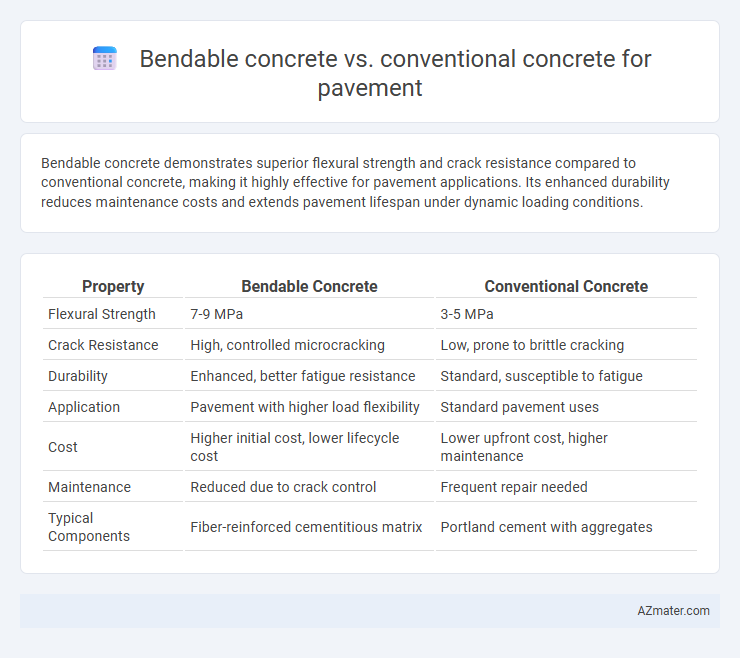Bendable concrete demonstrates superior flexural strength and crack resistance compared to conventional concrete, making it highly effective for pavement applications. Its enhanced durability reduces maintenance costs and extends pavement lifespan under dynamic loading conditions.
Table of Comparison
| Property | Bendable Concrete | Conventional Concrete |
|---|---|---|
| Flexural Strength | 7-9 MPa | 3-5 MPa |
| Crack Resistance | High, controlled microcracking | Low, prone to brittle cracking |
| Durability | Enhanced, better fatigue resistance | Standard, susceptible to fatigue |
| Application | Pavement with higher load flexibility | Standard pavement uses |
| Cost | Higher initial cost, lower lifecycle cost | Lower upfront cost, higher maintenance |
| Maintenance | Reduced due to crack control | Frequent repair needed |
| Typical Components | Fiber-reinforced cementitious matrix | Portland cement with aggregates |
Introduction to Bendable and Conventional Concrete
Bendable concrete, also known as engineered cementitious composite (ECC), is designed with added fibers that enhance its tensile strength and flexibility, allowing it to resist cracking under stress. Conventional concrete, commonly used in pavements, is a brittle material that relies on compressive strength but often suffers from cracking due to limited tensile capacity. The introduction of bendable concrete in pavement applications improves durability and reduces maintenance by bridging cracks and distributing stress more effectively compared to traditional concrete.
Key Differences Between Bendable and Conventional Concrete
Bendable concrete, also known as fiber-reinforced concrete, incorporates fibers such as polypropylene or glass to improve tensile strength and crack resistance, whereas conventional concrete relies primarily on compressive strength and is prone to brittle failure under tensile stress. This enhancement in ductility allows bendable concrete pavements to better withstand heavy traffic loads and thermal expansion, reducing maintenance costs and prolonging pavement life. Conventional concrete pavements often require joints and frequent repairs due to cracking, while bendable concrete minimizes these issues through improved crack control and flexibility.
Composition and Material Science
Bendable concrete incorporates engineered fibers such as polyvinyl alcohol (PVA) or polyethylene fibers within a high-performance cementitious matrix, enhancing tensile strength and crack resistance compared to conventional concrete, which relies primarily on coarse aggregates, cement, and water. The innovative composition of bendable concrete distributes stress more effectively, allowing for improved flexural performance and ductility crucial for pavement applications subjected to dynamic loads. Material science advancements in fiber-matrix interaction optimize durability and reduce microcracking, positioning bendable concrete as a superior alternative to traditional rigid pavement materials.
Flexural Strength and Crack Resistance
Bendable concrete exhibits significantly higher flexural strength compared to conventional concrete, making it more effective in withstanding heavy traffic loads and temperature fluctuations in pavement applications. Its enhanced crack resistance stems from the integration of engineered fibers or other reinforcing materials, which help distribute stress and prevent the propagation of cracks under bending stresses. This improved durability extends pavement lifespan and reduces maintenance costs compared to traditional concrete pavement systems.
Durability and Longevity in Pavement Applications
Bendable concrete exhibits superior durability and longevity compared to conventional concrete in pavement applications due to its enhanced crack resistance and flexibility. Its higher tensile strength and controlled shrinkage reduce the likelihood of surface deterioration and structural failures under heavy traffic loads. Conventional concrete, while strong in compression, is more prone to brittle cracking and requires more frequent maintenance, limiting its effective lifespan in pavement use.
Installation Process and Workability
Bendable concrete offers increased flexibility and crack resistance compared to conventional concrete, simplifying the installation process by reducing the need for joints and reinforcements in pavement applications. Its enhanced workability allows easier placement and finishing, minimizing labor time and costs. Conventional concrete requires more precise joint placement and higher reinforcement, increasing installation complexity and maintenance over time.
Cost Analysis and Economic Feasibility
Bendable concrete, also known as engineered cementitious composite, offers enhanced crack resistance and longer lifespan compared to conventional concrete, reducing maintenance and rehabilitation costs in pavement applications. Although the initial material cost of bendable concrete can be 30-50% higher, life-cycle cost analysis shows potential savings of up to 20-40% over 20 years due to decreased repair frequency and extended service intervals. Economic feasibility improves in high-traffic or harsh environmental conditions where durability directly translates into reduced user delays and lower total infrastructure expenditure.
Environmental Impact and Sustainability
Bendable concrete, also known as engineered cementitious composite (ECC), offers enhanced durability and crack resistance compared to conventional concrete, reducing repair frequency and extending pavement lifespan, which lowers overall carbon emissions from maintenance activities. Its composition often includes recycled materials and requires less cement, decreasing the embodied carbon footprint relative to traditional concrete pavements. These sustainability benefits contribute to reduced resource consumption and minimized environmental impact, making bendable concrete a greener alternative for sustainable infrastructure development.
Real-World Case Studies and Performance
Bendable concrete, also known as engineered cementitious composite (ECC), demonstrates superior crack resistance and durability compared to conventional concrete in pavement applications, as evidenced by various real-world case studies from California and Japan. These studies reveal a significant reduction in maintenance costs and extended service life due to bendable concrete's enhanced strain capacity and self-healing properties. Performance evaluations highlight improved fatigue resistance and fewer surface defects, leading to increased pavement longevity under heavy traffic loads.
Choosing the Right Concrete for Pavement Projects
Bendable concrete, also known as engineered cementitious composite, offers superior tensile strength and crack resistance compared to conventional concrete, making it ideal for pavements prone to heavy traffic loads and thermal expansion. Conventional concrete remains cost-effective and widely used for standard pavement projects with lower stress demands and shorter lifespans. Selecting the right concrete depends on project-specific factors such as expected traffic volume, environmental conditions, maintenance budget, and longevity requirements.

Infographic: Bendable concrete vs Conventional concrete for Pavement
 azmater.com
azmater.com